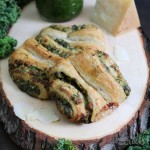Description
The savory version from a traditional bake from Hamburg: Franzbrötchen. Normally sweet with cinnamon, but this version has a kale pesto filling. Delicious!
Ingredients
For the kale filling:
5.3 oz. (150g) kale
3.5 oz. (100g) pine nuts
1 garlic clove
1/3 to 1/2 cup (80-120ml) cold-pressed olive oil
3.5 oz. (100g) grana padano cheese
For the dough:
3/4 cup (180ml) milk
1 tsp. sugar
1 oz. (30g) fresh yeast
4 1/4 cups (550g) all-purpose flour
2 tsp. salt
1/3 cup (75g) butter
1/4 cup (50g) sugar
2 medium eggs
1 cup (230g) cold butter
Instructions
1. Let the kale soak for about 10 minutes in some water, then clean with running water and let drain. Cut into small pieces and set aside.
2. Roast the pine nuts in a pan without fat until fragrant – be careful not to burn them. Remove from the heat and let cool down on a kitchen towel. Peel the garlic and cut it in half. Grate the cheese.
3. Add kale, roasted pine nuts, garlic, and about 1/3 of the cheese to a blender. Add about 1/3 cup (80ml) of the olive oil to the mixer and start mixing, add more oil if needed. You should get a thick paste, not too finely mixed. Set aside.
4. Preheat the oven to 120˚F (50°C) and then turn it off again. In a small bowl, mix the lukewarm milk with sugar and the yeast until dissolved. Cover and let rise for about 5 minutes. Sift the flour into a large bowl and add salt, the butter in small pieces, sugar, eggs, and the yeast milk. Knead until you get a nice smooth dough (with a food processor), then knead some minutes with your hands on a floured surface and form a ball. Place in the bowl again and cover with a kitchen towel or plastic wrap. Place in the oven and let rise for about 45 minutes – the volume should almost double.
5. As soon as the dough is in the oven, take the cold butter and wrap it loosely in plastic wrap. Take a rolling pin and hit the butter several times so it softens, then roll out to a 0.4 inches (1cm) thick square. It works best if you loosen the plastic wrap from time to time so it does not tear. When you’re done, place the butter square (still wrapped in plastic wrap) in the fridge.
6. Roll out the dough on a floured surface to a large square (it should be bigger than your butter square). Unwrap your butter, place it on the dough and fold the dough like an envelope over the butter. Make sure the butter is wrapped completely, then turn around and roll out to a long rectangle. Fold the ends towards the middle, one over the other. Wrap in plastic wrap and place in the fridge for 20-25 minutes.
7. Take the dough out of the fridge and repeat the rolling and folding – this time fold both sides to the middle and then one over the other. Wrap in plastic wrap and place again in the fridge for 20-25 minutes.
8. Preheat the oven to 390˚F (200°C). Line two baking sheets with baking parchment. Take the dough out of the fridge and roll it out to a large rectangle. Spread the kale mixture on top of the dough and sprinkle with half of the remaining cheese. Roll up to a log from the long side and cut into 2 inches (5cm) thick slices. Flatten them a bit and use the back of a wooden spoon to make a “notch” into the roll – dough and filling should ooze out a bit left and right – that gives the “franzbröchen” their typical shape. Place on the baking sheets with enough space in between, sprinkle with the remaining cheese and bake for 15-20 minutes. They should get a nice color but not too dark. Take out of the oven and let cool down on a wire rack completely.
Notes
Depending on the oven you have I recommend baking only one baking sheet at a time.
